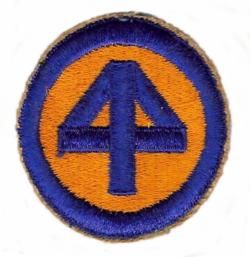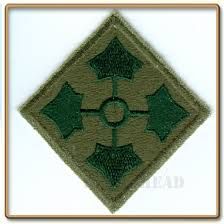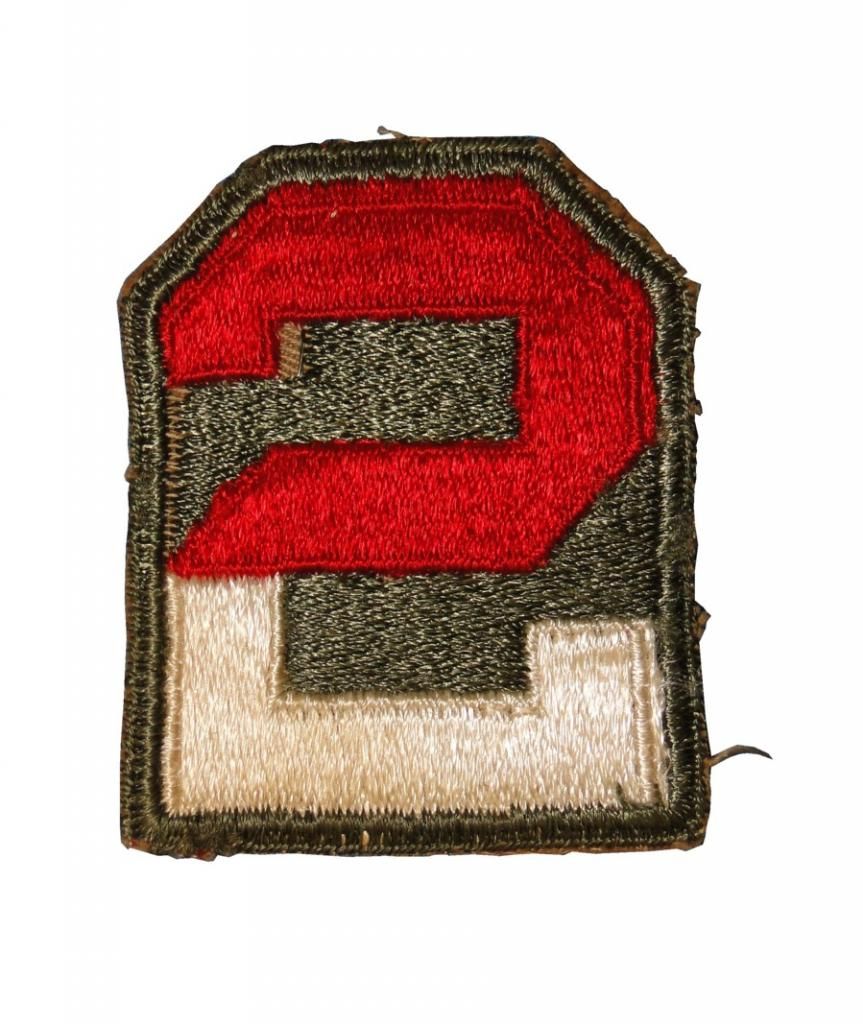I've had a friend help with some of the patches and really enjoying the history lessons,
44th Infantry Division

The 44th Infantry Division landed in France via Cherbourg, 15 September 1944, and trained for a month before entering combat, 18 October 1944, when it relieved the 79th Division in the vicinity of Foret de Parroy, east of Lunéville, France, to take part in the Seventh Army drive to secure several passes in the Vosges Mountains. Within 6 days, the division was hit by a heavy German counterattack, 25–26 October. The attack was repulsed and the 44th continued its active defense. On 13 November 1944, it jumped off in an attack northeast, forcing a passage through the Vosges Mountains east of Leintrey to Dossenheim, took Avricourt, 17 November, and pushed on to liberate Strasbourg, along with the 2d French Armored Division. After regrouping, the division returned to the attack, taking Ratzwiller and entering the Ensemble de Bitche in the Maginot Line. Fort Simserhof fell 19 December. Displacing to defensive positions east of Sarreguemines, 21–23 December, the 44th threw back three attempted crossings by the enemy of the Blies River.
Mickey Rooney entertains soldiers of the 44th Division in Kist, Germany during a May 1945 jeep tour.
An aggressive defense of the Sarreguemines area was continued throughout February 1945 and most of March. Moving across the Rhine at Worms, 26 March, in the wake of the 3d Division, the 44th relieved the 3d, 26–27 March, and crossed the Neckar River to attack and capture Mannheim, 28–29 March. Shifting to the west bank of the Main, the division crossed that river at Gross-Auheim in early April, and engaged in a 3-week training period. Attacking 18 April, after the 10th Armored Division, the 44th took Ehingen, 23 April, crossed the Danube, and attacking southeast, took Füssen, Berg, and Wertach, in a drive on Imst. On 2 May, a group of V-2 rocket scientists surrendered to the 44th. Pursuing the disintegrating enemy through Fern Pass[10] and into the Inn River valley, the 44th set up its CP at Imst, Austria, on 4 May. After a short period of occupation duty, the division returned to the United States in July 1945 for retraining prior to redeployment, but the end of the Pacific war resulted in inactivation in November 1945 at Camp Chaffee, AR.
http://www.combatreels.com/44th_infantry_division_1944-1945_dvd.cfm---------------------------------------------------------------------------------------------------------------------------------------------------------------------------------------------------------
4th Infantry Division

WW1
The 4th Division was organized at Camp Greene, North Carolina on 10 December 1917 under the command of Maj. Gen. George H. Cameron. It was here they adopted their distinctive insignia, the four ivy leaves. The ivy leaf came from the Roman numerals for four (IV) and signified their motto “Steadfast and Loyal”. The division was organized as part of the United States buildup following the Declaration of War on 6 April 1917 and the entry of the United States into the war on the side of the British and French.
St. Mihiel Offensive
Meuse-Argonne Campaign
Meuse-Argonne Offensive—Phase I
WW2
France
The 4th Infantry Division assaulted the northern coast of German-held France during the Normandy Invasion, landing at Utah Beach. The 8th Infantry Regiment of the 4th Infantry Division claimed being the first surface-borne Allied unit (as opposed to the parachutist formations that were air-dropped earlier) to hit the beaches at Normandy on D-day, 6 June 1944. Relieving the isolated 82d Airborne Division at Sainte-Mère-Église, the 4th cleared the Cotentin peninsula and took part in the capture of Cherbourg on 25 June. After taking part in the fighting near Periers, 6–12 July, the division broke through the left flank of the German Seventh Army, helped stem the German drive toward Avranches, and by the end of August had moved to Paris, and gave French forces the first place in the liberation of their capital. During the liberation of Paris in World War II, Ernest Hemingway took on a self-appointed role as a civilian scout in the city of Paris for his friends in the 4 ID. He was with the 22nd Infantry Regiment when it moved from Paris, northeast through Belgium, and into Germany. J. D. Salinger, who met Hemingway during the liberation of Paris, was with the 12th Regiment (4th Infantry Division).
Belgium, Luxembourg, and Germany
The 4th then moved into Belgium through Houffalize to attack the Siegfried Line at Schnee Eifel on 14 September, and made several penetrations. Slow progress into Germany continued in October, and by 6 November the division entered the Battle of Hurtgen Forest, where it was engaged in heavy fighting until early December. It then shifted to Luxembourg, only to meet the German winter Ardennes Offensive head-on (in the Battle of the Bulge) starting on 16 December 1944. Although its lines were dented, it managed to hold the Germans at Dickweiler and Osweiler, and, counterattacking in January across the Sauer, overran German positions in Fouhren and Vianden. Halted at the Prüm River in February by heavy enemy resistance, the division finally crossed on 28 February near Olzheim, and raced on across the Kyll on 7 March. After a short rest, the 4th moved across the Rhine on 29 March at Worms, attacked and secured Würzburg and by 3 April had established a bridgehead across the Main at Ochsenfurt. Speeding southeast across Bavaria, the division had reached Miesbach on the Isar on 2 May 1945, when it was relieved and placed on occupation duty. Writer J.D. Salinger served with the division 1942–1945.
-----------------------------------------------------------------------------------------------------------------------------------------------------------------------------------------------------------
US 13 Army Corps

Activated on 7 December 1942 in Providence, Rhode Island, the XIII Corps fought for 180 days in the European Theater of Operations, fighting from the Netherlands to the Elbe River. It was first activated under the command of then-Major General Emil F. Reinhardt, but would be commanded in combat by Major General (later Lieutenant General) Alvan C. Gillem, Jr. as a subordinate unit to Ninth U.S. Army, it under the command of the Allied 21st Army Group. In November 1944, the XIII Corps pierced the Siegfried Line and pushed to the Roer River. On 23 February 1945, the corps routed Third Reich forces in the Cologne Plain and made a dash for the Rhine River on 31 March of that year. In 180 days of combat, the corps had progressed as far as the Elbe River to the vicinity of Tangermunde, bringing it to approximately 50 miles from Berlin, the closest American forces would come to the enemy capital before V-E Day.
In total, the corps fought across more than 300 miles of enemy territory and captured more than 247,000 prisoners, as well as taking key cities, such as Viersen, Krefeld, Moers, Homburg, Münster, and Hannover. In the month following V-E Day, units from the corps were redeployed. Corps headquarters would eventually find its way to Camp Cooke, California, where on 25 September 1945, XIII Corps was inactivated.
-----------------------------------------------------------------------------------------------------------------------------------------------------------------------------------------------------

US 2nd Army
Second Army's task during the First World War was to hold the line a short distance east of the Moselle River in France following the end of the Saint-Mihiel offensive along the Western Front. The army was also tasked with reinforcing units from the active-in-combat soldiers of the U.S. First Army.
On November 9, 1918, Second Army was responsible for a frontline sector of 50 kilometers, held by four divisions totaling 43,000 men.[3] These divisions from left to right were the 33rd Division (Illinois Army National Guard), 28th Division (Pennsylvania National Guard), U.S. 7th Division (a regular formation) and 92nd Division (a Colored formation). In reserve were the 4th Division (a regular formation) and the 35th Division (Missouri and Kansas National Guard). One brigade of the 88th Division, a National Army formation raised in Minnesota and North Dakota, had just arrived at the front.
On 10 November, Second Army advanced on German positions, already in disorder and retreating. Word did not reach the units advancing until after eleven-hundred hours on 11 November, making it one of the last formations to fight to the very conclusion of the war. On 15 April 1919, Second Army was deactivated.
WW2
Second United States Army was reactivated on 1 October 1933 under a plan developed by then-Army Chief of Staff Douglas MacArthur to consolidate forces in the continental United States under four regional army commands.[4] It was headquartered in Memphis, Tennessee. In 1940, with the activation of Army General Headquarters (succeeded by Army Ground Forces in 1942), the four field armies were given responsibility for training forces in their respective areas and conducting maneuvers to evaluate training and readiness. In September 1941, Second U.S. Army participated in large-scale maneuvers pitting it against Third United States Army in what were known as the Louisiana Maneuvers.[5] Over 350,000 troops took part. Also in 1941, four regional defense commands were established coterminous with the army areas, and the Commander, Second U.S. Army became also Commanding General, Central Defense Command.
With First and Fourth Armies given primary responsibility for defense of the eastern and western coasts of the United States, and later with First Army's relocation to England to command U.S. Army forces in the invasion of France, Second and Third Armies assumed increasing responsibility for the training and organization of the rapidly expanding army and preparing troops for overseas deployment. When Third Army headquarters was relocated to France in 1944 to serve as a combat command, Second Army assumed its stateside responsibilities as well.
Second U.S. Army was commanded from 1940 to 1943 by Lt. Gen. Ben Lear. He was succeeded by Lt. Gen. Lloyd Fredendall after Fredendall's removal from command in North Africa. General Fredendall held command until war's end.
Mark